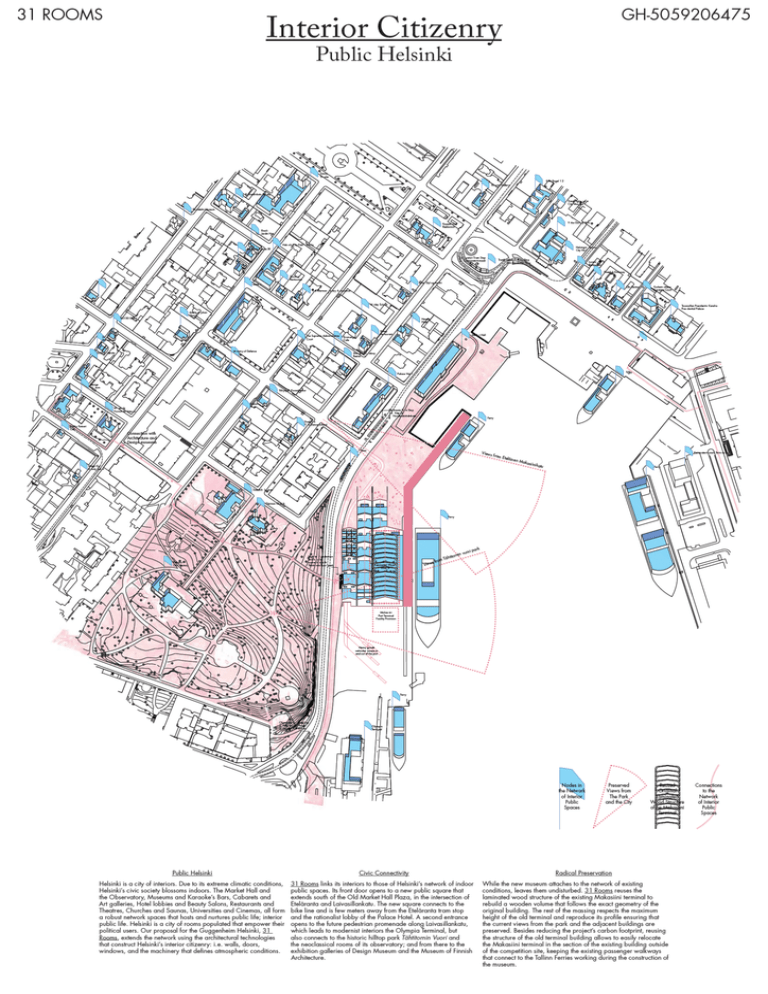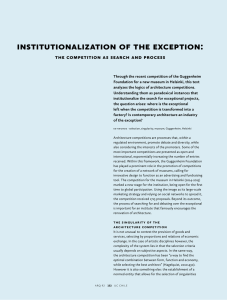View concept boards - Guggenheim Helsinki Design Competition
Anuncio

31 ROOMS GH-5059206475 Collection of Atmospheres Curatorial Hygrometry 1. In search of climate comfort 2. 3. Waitng 4. 5. 3. Opening Day 7. Screening 8. Museum Shopping 9. Installing 1:1 (the Square) 10. 11. Citizens Assembling 12. Learning from Guggenheims The Guggenheim Foundation exhibits its collection in three types of atmospheres. The reference collection 20th Century avant-garde masterpieces requires highly controlled atmospheres of 22ºC ±2.5ºC, with relative humidity of 51% ±5% and no natural light, conditions achieved in the Annex Galleries in the Solomon R. Guggenheim Museum and the classical galleries in the second floor of the Guggenheim Bilbao, and similar to the domestic rooms of the Peggy Guggenheim Collection in Venice. Curatorial Hygrometry The atrium of Wright´s Building, the Serra Gallery in Bilbao or the former Guggenheim Las Vegas main gallery regularly host site specific installations, performances and large scale (usually post1960s) pieces that accept more relaxed atmospheric conditions, interaction with the public and less controlled natural light. Finally, the recent BMW Guggenhem Lab, has engaged natural atmospheres in New York, Berlin and Mumbai exploring collective events, participatory processes and relational art. 31 Rooms expands this three conditions adding a range of other climatic definitions. The goal is twofold. First, it questions the climatic conventions that mediate each of the artistic categories mentioned before, including the hygrometric chart to the tool box of curatorial strategies. Second open up the list of acceptable museum climatic conditions assuming that different institutional atmospheres will eventually engender different art practices. Beyond its active inclusion of design and architecture in its program, the museum will represent a new model within the global Guggenheim constellation, offering an opportunity for the foundation to develop a museum of the future with radical, multidisciplinary approaches to engaging new audiences with culture at large. The Guggenheim Helsinki will become a curatorial innovation reference centre for the other Guggenheim museums. 31 ROOMS Part A – Concept description GH-5059206474 Interior Citizenry Public Helsinki: Helsinki is a city of interiors. Due to its extreme climatic conditions, Helsinki’s civic society blossoms indoors. The Market Hall and the Observatory, Museums and Karaoke’s Bars, Cabarets and Art galleries, Hotel lobbies and Beauty Salons, Restaurants and Theatres, Churches and Saunas, Universities and Cinemas, all form a robust network spaces that hosts and nurtures public life; interior public life. Helsinki is a city of rooms populated that empower their political users. Our proposal for the Guggenheim Helsinki, 31 Rooms, extends the network using the architectural technologies that construct Helsinki’s interior citizenry: i.e. walls, doors, windows, and the machinery that defines atmospheric conditions. Civic Connectivity: 31 Rooms links its interiors to those of Helsinki’s network of indoor public spaces. Its front door opens to a new public square that extends south of the Old Market Hall Plaza, in the intersection of Eteläranta and Laivasillankatu. The new square connects to the bike line and is few meters away from the Eteläranta tram stop and the rationalist lobby of the Palace Hotel. A second entrance opens to the future pedestrian promenade along Laivasillankatu, which leads to modernist interiors the Olympia Terminal, but also connects to the historic hilltop park Tähtitornin Vuori and the neoclassical rooms of its observatory; and from there to the exhibition galleries of Design Museum and the Museum of Finnish Architecture. Radical Preservation: While the new museum attaches to the network of existing conditions, leaves them undisturbed. 31 Rooms reuses the laminated wood structure of the existing Makasiini terminal to rebuild a wooden volume that follows the exact geometry of the original building. The rest of the massing respects the maximum height of the old terminal and reproduce its profile ensuring that the current views from the park and the adjacent buildings are preserved. Besides reducing the project’s carbon footprint, reusing the structure of the old terminal building allows to easily relocate the Makasiini terminal in the section of the existing building outside of the competition site, keeping the existing passenger walkways that connect to the Tallinn Ferries working during the construction of the museum. Institutional Weather Well-Tempered Identity: Historically, Guggenheim museums—with the exception of the historic palazzo in Venice that houses the Peggy Guggenheim Collection—have leant on strong iconic features to define the museums identity. New York vertical urbanity, Bilbao post-industrial landscape and Abu Dhabi eclectic skyline required it. Helsinki is an opportunity to continue this tradition of radical contextualism while shifting away from objecthood in favour of atmospheric conditions. The shift, already successfully tested in the BMW Guggenheim Lab, will embrace Helsinki specific urban conditions by focussing on its interior climate rather than its external morphology. In so doing, It will define a different kind of Guggenheim whose identity will respond to its internal weather. Flexible Rooms: 31 Rooms contains eight rooms of 20x20m, eighteen of 6.5x6.5m four of 10x10m and one of 40x100m. The biggest one reuses the existing laminated wood structure of the Makasiini terminal and hosts the exhibition spaces that can be combined or divided as needed. The rest offer an alternative notion of flexibility based on a rigid set of spatial conditions rather than temporal partitions. Over time, the rooms’ dimensions won’t change over time while the way they are used will, 1 of 3 31 ROOMS Part A – Concept description GH-5059206474 opening to new uses not prescribed in the design. The public square north of the site is room 32nd. Wired similarly to the rest of the groups, offers a site for design and architectural exhibition that deal with 1:1 scale and, at the same time, deploys museum-quality in the public real redefines public space. Thermal Onion: Each room is acclimatized independent, forming a thermal onion in the northwest side of the building which optimizes climate areas according to levels of access, and makes use of the thermal inertia of the concrete slab. Since energy loss grows exponentially with temperature difference, it is much more efficient to have several layers of climate control, than to temper a building homogeneously. In 31 Rooms the temperature on the rooms on the perimeter is not as high as the core of the building (15º C, +/- 4º C, in the lobbies), reaching comfort temperature gradually as you reach the larger exhibition space, which to maintains a temperature of 22ºC ±2.5ºC, with relative humidity of 51% ±5%. The Politics of the Sauna Productive (Climatic) Disagreements: Finnish saunas are one of the most advanced models of public interior spaces. Conceived as meeting places for naked bodies, their users assume extraordinary levels of intimacy that question accepted notions of public sociability. But more importantly, saunas use participation to define weather conditions. Pouring water on the stove rocks, a group of people, not necessarily familiar to each other, negotiate collective levels of comfort which can range from 70ºC to 90ºC and from 5% to 20% humidity. 31 Rooms appropriates this logic to define the climatic conditions of its interiors. The HVAC will define the Guggenheim Helsinki identity, but it won’t do it as a topdown imposition. Rather, the interior climate will be negotiated with a civil society trained and habituated to define its public arenas this way. Atmospheric Technologies: Using ordinary off-the-shelf architectural technologies, 31 Rooms extends the logic through which Helsinki’s population tempers their more intimate public spaces and by extension construct their interior citizenry. Each room’s final climatic conditions include certain degree of negotiation between the institution and its visitors. The mechanisms include (1) furniture heated using geothermal energy and solar/thermal curtains to create micro climates within a room, (2) potted plants that change the humidity levels of a room according to its proximity to AC vents, (3) Green houses with its own independent heat/cooling source that allow the micromanagement of a climatic bubble within a room and Swimming-poool-like retractable rooftops that can completely open three rooms to the weather outside. Limits of Participation: According to its function, each room accepts different degrees of climatic negotiation. The larger exhibition space maintains a temperature of 22ºC ±2.5ºC, with relative humidity of 51% ±5% and leaves no space for interaction. Alternatively, the lobby allows for constellation of microclimates in constant flux. Yet there are atmospheric conditions that are not negotiable and they define ‘31 Rooms’ material decisions. (1) The museum walls are built using a 9x2.5m panel sandwich of Cross-laminated-Timber (CLT) and insulation which grants 0.10-0.20 U-values. (2) The concrete slabs incorporate floor heating/cooling systems that combine the museum’s geothermic system and the district heating system. (3) The Roof is a combination of two air pillows—with the exception of the larger exhibition space that uses a CLT sandwich panel similar to the walls. The first one is double layer EFTE pillow. The second encloses the roof structure, controls the level of natural light and allows for multiple climatic configurations. 2 of 3 31 ROOMS Part A – Concept description GH-5059206474 Collection of Atmospheres Learning from Guggenheims: The Guggenheim Foundation exhibits its collection in three types of atmospheres. The reference collection 20th Century avant-garde masterpieces requires highly controlled atmospheres of 22ºC ±2.5ºC, with relative humidity of 51% ±5% and no natural light, conditions achieved in the Annex Galleries in the Solomon R. Guggenheim Museum and the classical galleries in the second floor of the Guggenheim Bilbao, and similar to the domestic rooms of the Peggy Guggenheim Collection in Venice. The atrium of Wright´s Building, the Serra Gallery in Bilbao or the former Guggenheim Las Vegas main gallery regularly host site specific installations, performances and large scale (usually post-1960s) pieces that accept more relaxed atmospheric conditions, interaction with the public and les controlled natural light. Finally, the recent BMW Guggenhem Lab, has engaged natural atmospheres in New York, Berlin and Mumbai exploring collective events, participatory processes and relational art. Curatorial Hygrometry: 31 Rooms expands this three conditions adding a range of other climatic definitions. The goal is twofold. First, it questions the climatic conventions that mediate each of the artistic categories mentioned before, including the hygrometric chart to the tool box of curatorial strategies. Second open up the list of acceptable museum climatic conditions assuming that different institutional atmospheres will eventually engender different art practices. Beyond its active inclusion of design and architecture in its programme, the museum will represent a new model within the global Guggenheim constellation, offering an opportunity for the foundation to develop a museum of the future with radical, multidisciplinary approaches to engaging new audiences with culture at large. The Guggenheim Helsinki will become a curatorial innovation reference centre for the other Guggenheim museums. 3 of 3


